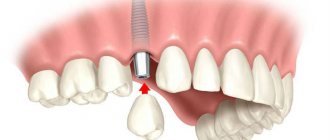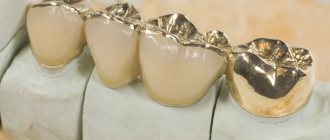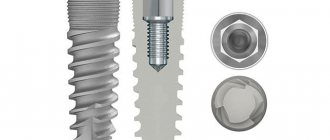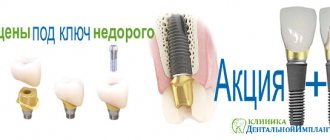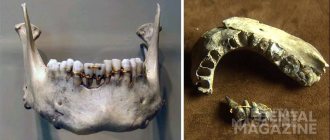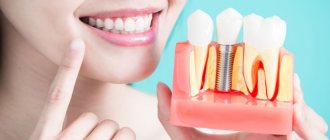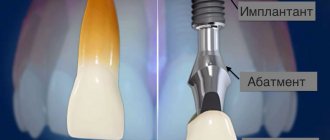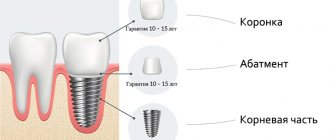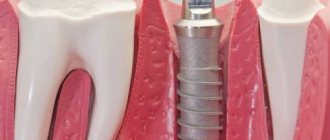In case of tooth loss, implantation can be a solution to the problem. If the patient is missing two elements of the dentition, different modifications of the rods and methods of their implantation are used. The choice of specific products is determined taking into account which part of the jaw the operation is performed on. You can often come across the question of whether it is possible to restore two lost teeth at once by installing one implant. This publication will discuss the various features and subtleties of implanting two adjacent teeth.
Is it possible to replace a pair of teeth with one implant?
Dentists very rarely install one rod to restore two teeth. If the specialist prefers this solution, he will have to install not a pair of separate implants, but a bridge, which includes 3 crowns. The extreme elements ensure reliable fastening of the bridge. One crown is attached to a healthy tooth, which requires preliminary preparation. And the second is attached to the previously installed implant. This technology has certain “disadvantages”:
- the need to depulpate and grind down a completely healthy tooth, which weakens it;
- under the blind crown, the bone continues to atrophy, as a result of which a gap is formed between it and the edge of the gum;
- minimal mobility of the dentition element and fusion of the bone and implant contribute to the appearance of a shock-absorbing effect, as a result of which the prosthesis gradually becomes looser.
As a result of all this, the reliability of the design leaves much to be desired. At one point, the patient may lose both the supporting tooth and the implant.
Is it possible to install two implants during one procedure?
The specialist can determine how many rods can realistically be installed in one procedure after a thorough diagnosis of the patient’s oral cavity. After an examination and CT scan, your dentist may recommend certain titanium rod options. The choice of artificial roots is influenced by:
- size and type of alveolar ridge;
- state of human health;
- distance from the rod installation area to the maxillary sinus and mandibular canal.
You need to visit the dentist more than once, even if only one implant is implanted, since the process includes such stages as a preliminary consultation, tomography, implantation and prosthetics. In some cases, bone grafting and certain other types of procedures may also need to be done.
Advantages of simultaneous installation of two implants:
- ease of control of osseointegration of two elements;
- no problems with bone atrophy;
- the number of visits to a specialist is usually the same as in the case of implantation of one implant;
- uniform load distribution;
- saving money on specialist services.
Which implants to choose - basal or classic?
So, on the one hand, the classic two-stage procedure is the most common and internationally recognized option for dental restoration. On the other hand, in some clinical situations it is more appropriate to perform basal implantation.
Among modern implantation methods, it is impossible to single out clearly good or bad. Only a doctor can select technologies that are suitable for a specific patient and his clinical case. Experienced dentists-implantologists of the “Full Order” clinics will select the appropriate method for restoring teeth, even in difficult cases.
Don't put off visiting your doctor! Just a few visits to the clinic can restore your health and the ability to smile freely.
Choosing the optimal model
The rating of implants is determined taking into account the survival rate, service life, and the percentage of postoperative complications. The process of osseointegration is influenced by the professionalism of the doctor, the individual characteristics of the patient’s body and the ability of its tissues to recover. The qualifications of a dentist are very important, since even the installation of expensive implants can lead to complications if there is no real experience in their implantation.
Today, the following implantation systems are considered the most reliable: Straumann - high-quality Swiss-made implants with a lifetime guarantee. According to statistics, these products take root very well.
XIVE are German implants with exclusive threads that ensure reliable fixation. Can even be used with cancellous bone.
Nobel Biocare are expensive implants, available in a wide range, so you can choose the optimal solution for each situation. The products are characterized by rapid osseointegration and are equipped with double threads.
Astra Tech - high-quality developments by Swedish specialists, characterized by good stability.
In the manufacture of Anthogyr implants (France), high-quality titanium is used, due to which the products are highly resistant to external factors.
For front teeth
Implants for the anterior regions must meet high requirements, and therefore they must be selected as carefully as possible. Primary requirements:
- optimal length and compact diameter for easy implantation;
- made of zirconium dioxide, so they will not show through the gums;
- Different sized threads at bottom and top for stability.
By choosing a suitable implant, a specialist can preserve the maximum amount of bone tissue, avoiding its loss. When working in the smile zone, a one-stage version of the procedure is used with the use of a temporary prosthesis or crowns on the day of implantation.
Average prices in Moscow
| Name of service | Cost in rub. |
| Consultations | |
| Dentist | 600 |
| Periodontologist | 740 |
| Implantologist | 820 |
| Diagnostics | |
| X-ray of the tooth | 340 |
| Orthopantomogram | 1100 |
| Computed tomography (fragment of the dentition up to 3 teeth) | 2200 |
| Preparation period | |
| Professional hygiene with ultrasound | 2000 |
| Relief of periodontal inflammation | 2500 |
| Teeth brushing using the Air Flow method | 3500 |
| Treatment of caries | |
| Superficial | 2800 |
| Average | 3200 |
| Glubokoye | 3800 |
| Bone tissue augmentation | |
| Implantation of osteoinductive material in the area of 1 tooth | 10900 |
| Closed sinus lift | 17700 |
| Open sinus lift | 36700 |
| Implantation of two implants by manufacturer | |
| Alfa Bio (Israel) | 32000 |
| Osstem (Korea) | 40000 |
| "ROOTT" (Switzerland) | 50000 |
| MIS (Israel) | 50000 |
| Astra Tech (Sweden) | 86000 |
| Straumann (Switzerland) | 102000 |
| Nobel Biocare (Switzerland) | 120000 |
| Crowns for 2 implants | |
| Temporary | 18000 |
| Metal-ceramic | 40000 |
| From zirconium dioxide | 73200 |
For the chewing area
Thicker rods are installed in the lateral parts of the jaw, the size of which depends on the anatomy and the distance between the elements of the dentition. The classic two-stage technique is usually used. It is necessary that the implant can withstand serious loads during the process of chewing food. The shape and color of dentures or crowns are selected taking into account similar characteristics of a person’s natural teeth.
Today, a large number of implants for molars and premolars are available from different manufacturers.
Installation of implants in cases where two adjacent teeth are missing. A traditional 2-stage scheme or a one-stage protocol with immediate loading can be used.
Indications and contraindications for production
A butterfly denture is made in the following clinical situations:
- Loss of 1-3 teeth in the front or side of the jaw;
- The need for prosthetics for 2-3 teeth;
- Partial edentia;
- Absence of a tooth by nature;
- Temporary replacement of a defect during the manufacture of a permanent structure;
- Inability to perform prosthetics using other prostheses;
- Presence of contraindications to implantation;
- Patient's wishes.
Contraindications to prosthetics are:
- Absence of more than 3 teeth in a row;
- Severe tissue atrophy;
- Periodontal diseases of adjacent teeth;
- Stomatitis, acute inflammatory processes in the oral cavity;
- Allergy to manufacturing materials (plastic, nylon);
- Deformation or defect of the alveolar process;
- Removal of the last molars, since their replacement is impractical.
Technology in 2 stages
Stages of the classical procedure:
- Installation of implants, which take about 2-6 months to take root. At this time, a plug is installed on the implant to prevent the penetration of pathogens. A special suture is placed on the gum.
- Prosthetics after completion of osseointegration. The specialist opens the gum, removes the plug and installs the abutment, followed by fixation of the crown.
1-1.5 weeks before installation of the abutment, an additional operation can sometimes be performed, during which the gum former is fixed to achieve its optimal shape. The name of the technique does not mean that you only need to visit the doctor twice. It is mandatory to undergo a diagnostic stage, treat existing dental diseases, and also perform bone grafting (not in all cases). During the second stage, the specialist also makes an impression.
One-stage implantation
This version of the procedure is known as Immediate Load. The installation of crowns occurs immediately after implantation of implants and fastening of abutments. The duration of treatment is several days, but this is only relevant for those cases when there is no need to treat gum inflammation, treat or remove nearby teeth and eliminate other problems.
Key stages:
- Diagnosis of the patient’s teeth, gums and general health, testing, orthopantomogram and computed tomography examination.
- Selecting the optimal location for installing implants with the production of special templates.
- Implantation (approximately 30 minutes).
- Making impressions for the production of prostheses.
- Installation of crowns using a screw or glue.
Features of bone volume restoration and sinus lift
Tooth extraction entails jaw atrophy, so experts advise installing an implant as quickly as possible. If there is a loss of bone tissue, it is necessary to build it up to create good support for installing a titanium root.
There are different options for the procedure:
- Autotransplantation. Specialists perform a bone transplant from a patient from another area. The advantage of the solution is the minimal risk of rejection.
- Replanting artificial fabric.
- Sinus lift. Augmentation of bone tissue in the upper jaw by correcting the position of the lower wall of the nasal sinus. The vacated space is filled with a special material of artificial origin.
- Expansion of bone by splitting the alveolar ridge.
The duration of the bone tissue augmentation procedure is from 4 to 6 months. After this, the implants are installed.
Types of basal implants
Basal implants can have different designs. The choice of one of these designs depends on the specific clinical case.
- Disc basal structures are not used in modern dental practice because they are already outdated. They get their name from their disc-like shape.
- Long threaded titanium rods. Such implants are designed for installation in the deepest layers of bone and are suitable even for patients with severe bone tissue atrophy. Thanks to the pronounced thread, the design is securely fixed in hard tissues.
- Zygomatic upper dental implants. They are implanted into the cheekbone and are often used during All-on-4 and All-on-6 surgeries.
- Compression implants. They are usually installed in narrow dental spaces for single prosthetics. The implant is implanted simultaneously into the cancellous and cortical bone. Spongy bone is higher than cortical bone, and therefore it is more susceptible to atrophy. Because of this feature, the design is used only when there is a moderate reduction in the volume of the jawbone.
Service life of basal implants and rules of care for them
With proper care and the absence of complications, the service life of basal structures is 20 years, but they can easily last a lifetime. Caring for implants begins from the first day of their installation. On this day you must follow these recommendations:
- do not eat or drink for 1-2 hours after surgery;
- For 1 day after the procedure, do not take a hot bath, avoid physical activity, visiting the pool and sauna.
In the future, it is important to follow simple rules:
- rinse your mouth after eating with warm water or special solutions recommended by your doctor;
- brush your teeth morning and evening using a soft toothbrush;
- carry out professional oral hygiene at least once every six months;
- Regularly visit the dentist, who will be able to promptly notice and correct changes in the area of the restored teeth if they occur.
